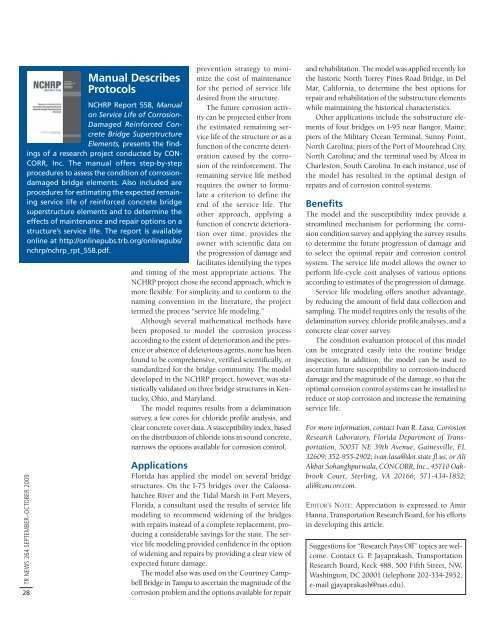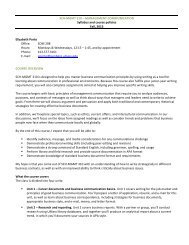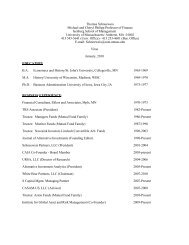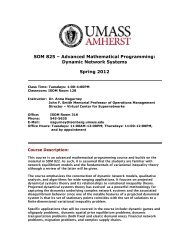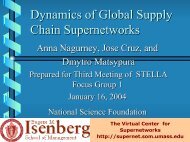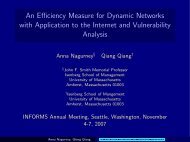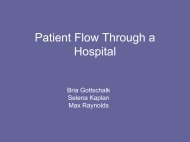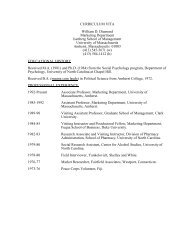TR News - Transportation Research Board
TR News - Transportation Research Board
TR News - Transportation Research Board
- No tags were found...
Create successful ePaper yourself
Turn your PDF publications into a flip-book with our unique Google optimized e-Paper software.
<strong>TR</strong> NEWS 264 SEPTEMBER–OCTOBER 200928prevention strategy to minimizethe cost of maintenancefor the period of service lifedesired from the structure.The future corrosion activitycan be projected either fromthe estimated remaining servicelife of the structure or as afunction of the concrete deteriorationcaused by the corrosionof the reinforcement. Theremaining service life methodrequires the owner to formulatea criterion to define theend of the service life. Theother approach, applying afunction of concrete deteriorationover time, provides theowner with scientific data onthe progression of damage andfacilitates identifying the typesand timing of the most appropriate actions. TheNCHRP project chose the second approach, which ismore flexible. For simplicity and to conform to thenaming convention in the literature, the projecttermed the process “service life modeling.”Although several mathematical methods havebeen proposed to model the corrosion processaccording to the extent of deterioration and the presenceor absence of deleterious agents, none has beenfound to be comprehensive, verified scientifically, orstandardized for the bridge community. The modeldeveloped in the NCHRP project, however, was statisticallyvalidated on three bridge structures in Kentucky,Ohio, and Maryland.The model requires results from a delaminationsurvey, a few cores for chloride profile analysis, andclear concrete cover data. A susceptibility index, basedon the distribution of chloride ions in sound concrete,narrows the options available for corrosion control.Manual DescribesProtocolsNCHRP Report 558, Manualon Service Life of Corrosion-Damaged Reinforced ConcreteBridge SuperstructureElements, presents the findingsof a research project conducted by CON-CORR, Inc. The manual offers step-by-stepprocedures to assess the condition of corrosiondamagedbridge elements. Also included areprocedures for estimating the expected remainingservice life of reinforced concrete bridgesuperstructure elements and to determine theeffects of maintenance and repair options on astructure’s service life. The report is availableonline at http://onlinepubs.trb.org/onlinepubs/nchrp/nchrp_rpt_558.pdf.ApplicationsFlorida has applied the model on several bridgestructures. On the I-75 bridges over the CaloosahatcheeRiver and the Tidal Marsh in Fort Meyers,Florida, a consultant used the results of service lifemodeling to recommend widening of the bridgeswith repairs instead of a complete replacement, producinga considerable savings for the state. The servicelife modeling provided confidence in the optionof widening and repairs by providing a clear view ofexpected future damage.The model also was used on the Courtney CampbellBridge in Tampa to ascertain the magnitude of thecorrosion problem and the options available for repairand rehabilitation. The model was applied recently forthe historic North Torrey Pines Road Bridge, in DelMar, California, to determine the best options forrepair and rehabilitation of the substructure elementswhile maintaining the historical characteristics.Other applications include the substructure elementsof four bridges on I-95 near Bangor, Maine;piers of the Military Ocean Terminal, Sunny Point,North Carolina; piers of the Port of Moorehead City,North Carolina; and the terminal used by Alcoa inCharleston, South Carolina. In each instance, use ofthe model has resulted in the optimal design ofrepairs and of corrosion control systems.BenefitsThe model and the susceptibility index provide astreamlined mechanism for performing the corrosioncondition survey and applying the survey resultsto determine the future progression of damage andto select the optimal repair and corrosion controlsystem. The service life model allows the owner toperform life-cycle cost analyses of various optionsaccording to estimates of the progression of damage.Service life modeling offers another advantage,by reducing the amount of field data collection andsampling. The model requires only the results of thedelamination survey, chloride profile analyses, and aconcrete clear cover survey.The condition evaluation protocol of this modelcan be integrated easily into the routine bridgeinspection. In addition, the model can be used toascertain future susceptibility to corrosion-induceddamage and the magnitude of the damage, so that theoptimal corrosion control systems can be installed toreduce or stop corrosion and increase the remainingservice life.For more information, contact Ivan R. Lasa, Corrosion<strong>Research</strong> Laboratory, Florida Department of <strong>Transportation</strong>,50057 NE 39th Avenue, Gainesville, FL32609; 352-955-2902; ivan.lasa@dot.state.fl.us; or AliAkbar Sohanghpurwala, CONCORR, Inc., 45710 OakbrookCourt, Sterling, VA 20166; 571-434-1852;ali@concorr.com.EDITOR’S NOTE: Appreciation is expressed to AmirHanna, <strong>Transportation</strong> <strong>Research</strong> <strong>Board</strong>, for his effortsin developing this article.Suggestions for “<strong>Research</strong> Pays Off” topics are welcome.Contact G. P. Jayaprakash, <strong>Transportation</strong><strong>Research</strong> <strong>Board</strong>, Keck 488, 500 Fifth Street, NW,Washington, DC 20001 (telephone 202-334-2952,e-mail gjayaprakash@nas.edu).


